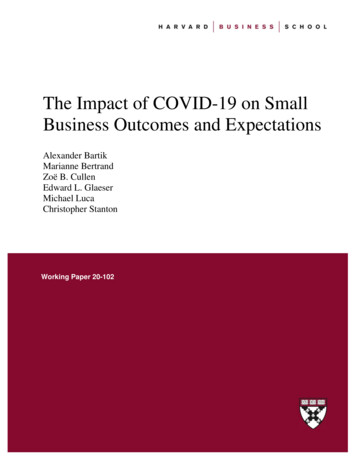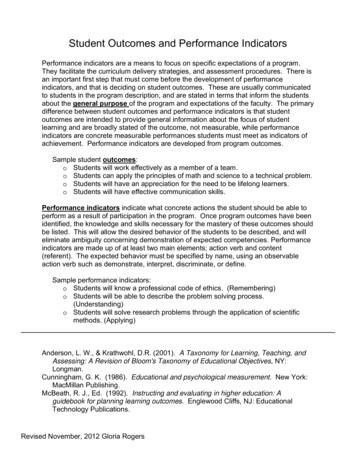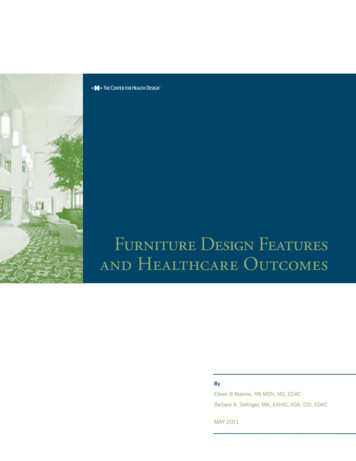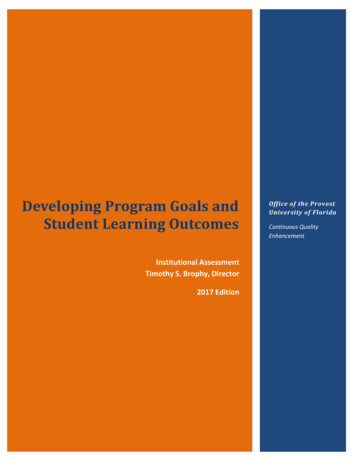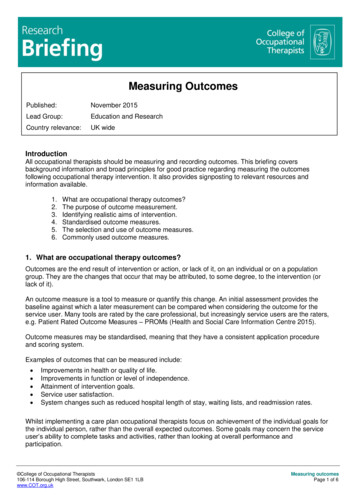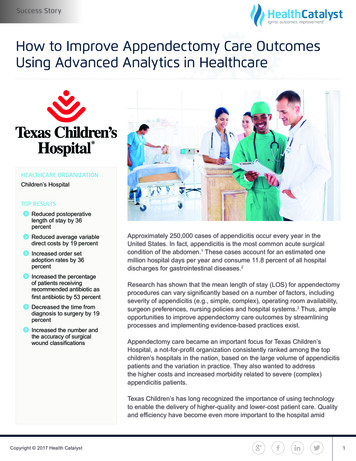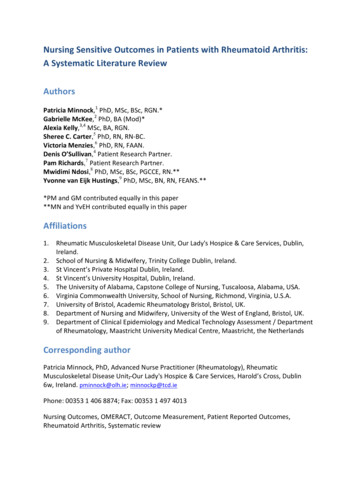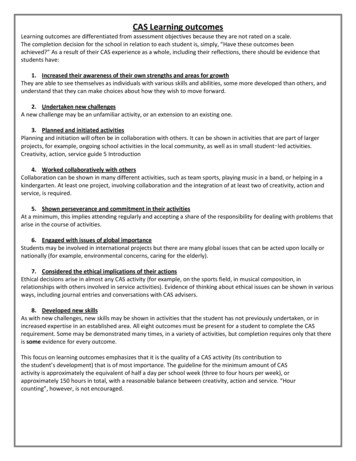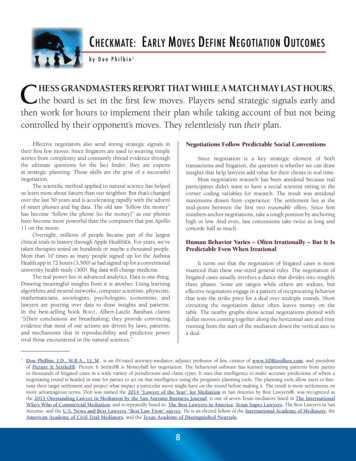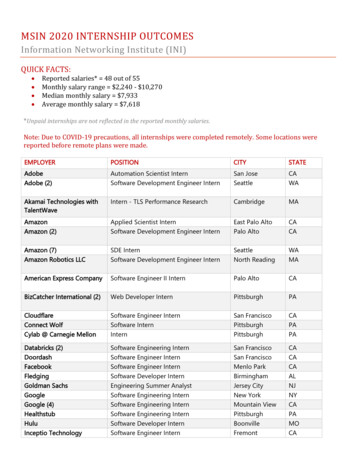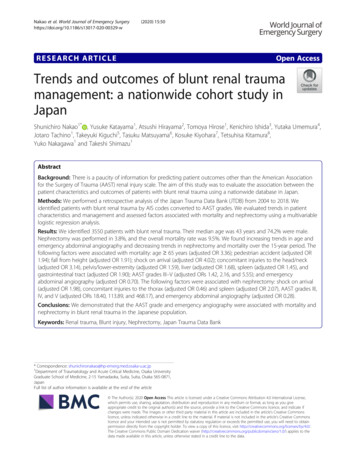
Transcription
Nakao et al. World Journal of Emergency 2020) 15:50RESEARCH ARTICLEOpen AccessTrends and outcomes of blunt renal traumamanagement: a nationwide cohort study inJapanShunichiro Nakao1* , Yusuke Katayama1, Atsushi Hirayama2, Tomoya Hirose1, Kenichiro Ishida3, Yutaka Umemura4,Jotaro Tachino1, Takeyuki Kiguchi5, Tasuku Matsuyama6, Kosuke Kiyohara7, Tetsuhisa Kitamura8,Yuko Nakagawa1 and Takeshi Shimazu1AbstractBackground: There is a paucity of information for predicting patient outcomes other than the American Associationfor the Surgery of Trauma (AAST) renal injury scale. The aim of this study was to evaluate the association between thepatient characteristics and outcomes of patients with blunt renal trauma using a nationwide database in Japan.Methods: We performed a retrospective analysis of the Japan Trauma Data Bank (JTDB) from 2004 to 2018. Weidentified patients with blunt renal trauma by AIS codes converted to AAST grades. We evaluated trends in patientcharacteristics and management and assessed factors associated with mortality and nephrectomy using a multivariablelogistic regression analysis.Results: We identified 3550 patients with blunt renal trauma. Their median age was 43 years and 74.2% were male.Nephrectomy was performed in 3.8%, and the overall mortality rate was 9.5%. We found increasing trends in age andemergency abdominal angiography and decreasing trends in nephrectomy and mortality over the 15-year period. Thefollowing factors were associated with mortality: age 65 years (adjusted OR 3.36); pedestrian accident (adjusted OR1.94); fall from height (adjusted OR 1.91); shock on arrival (adjusted OR 4.02); concomitant injuries to the head/neck(adjusted OR 3.14), pelvis/lower-extremity (adjusted OR 1.59), liver (adjusted OR 1.68), spleen (adjusted OR 1.45), andgastrointestinal tract (adjusted OR 1.90); AAST grades III–V (adjusted ORs 1.42, 2.16, and 5.55); and emergencyabdominal angiography (adjusted OR 0.70). The following factors were associated with nephrectomy: shock on arrival(adjusted OR 1.98), concomitant injuries to the thorax (adjusted OR 0.46) and spleen (adjusted OR 2.07), AAST grades III,IV, and V (adjusted ORs 18.40, 113.89, and 468.17), and emergency abdominal angiography (adjusted OR 0.28).Conclusions: We demonstrated that the AAST grade and emergency angiography were associated with mortality andnephrectomy in blunt renal trauma in the Japanese population.Keywords: Renal trauma, Blunt injury, Nephrectomy, Japan Trauma Data Bank* Correspondence: ent of Traumatology and Acute Critical Medicine, Osaka UniversityGraduate School of Medicine, 2-15 Yamadaoka, Suita, Suita, Osaka 565-0871,JapanFull list of author information is available at the end of the article The Author(s). 2020 Open Access This article is licensed under a Creative Commons Attribution 4.0 International License,which permits use, sharing, adaptation, distribution and reproduction in any medium or format, as long as you giveappropriate credit to the original author(s) and the source, provide a link to the Creative Commons licence, and indicate ifchanges were made. The images or other third party material in this article are included in the article's Creative Commonslicence, unless indicated otherwise in a credit line to the material. If material is not included in the article's Creative Commonslicence and your intended use is not permitted by statutory regulation or exceeds the permitted use, you will need to obtainpermission directly from the copyright holder. To view a copy of this licence, visit http://creativecommons.org/licenses/by/4.0/.The Creative Commons Public Domain Dedication waiver ) applies to thedata made available in this article, unless otherwise stated in a credit line to the data.
Nakao et al. World Journal of Emergency Surgery(2020) 15:50BackgroundRenal trauma, which accounts for 1–5% of all traumaand up to 10% of abdominal trauma, is predominantlycaused by blunt mechanisms of injury [1, 2]. A previoussystematic review in 2005 noted that non-operativemanagement of renal trauma was not yet universally accepted, despite the fact that many studies supportednon-operative management [3]. However, more recentsystematic reviews have reported favorable outcomes ofnon-operative management, even in high-grade renaltrauma [4, 5]. In recent years, less invasive interventions,such as endovascular procedures, have increasingly beenused for blunt renal trauma [6, 7]. Nevertheless, nephrectomy is still required for unstable patients those inwhom non-operative management fails [8–10]. According to a report by van der Wilden et al., among patientsinjured by road traffic accidents, non-operative management failed in 27.3% of the patients who were 55 yearsof age [11]. It is important to identify patients who require nephrectomy after renal trauma.While multiple studies have shown the efficacy andsafety of non-operative management, there is still a paucity of information on the characteristics of blunt renaltrauma and current managements and their trends. Furthermore, there is little evidence on predictors of theneed for nephrectomy other than the American Association for the Surgery of Trauma (AAST) renal injuryscale [12]. The aim of this study was to evaluate the association between patient characteristics and outcomessuch as mortality and the need for nephrectomy in patients with blunt renal trauma using a nationwide database in Japan, in considering trends in management.MethodsStudy design and settingWe performed a retrospective analysis of the JapanTrauma Data Bank (JTDB). The institutional ethics committee of Osaka University Graduate School of Medicineapproved this study and waived the requirement for informed consent because all of the analyses used anonymous data (approval no. 16260).Japan Trauma Data BankThe JTDB is a nationwide voluntary hospital-basedtrauma registry that was established in 2003 by the Japanese Association for the Surgery and Trauma (TraumaSurgery Committee) and the Japanese Association forAcute Medicine (Committee for Clinical Care Evaluation) [13]. In 2018, 280 major emergency medical institutions across Japan participated in the JTDB registry[14]. The ability of these hospitals is equivalent to thatof level I trauma centers in the USA. Data were collectedfrom participating institutions via the internet. In mostcases, physicians and medical assistants who completedPage 2 of 11the Abbreviated Injury Scale (AIS) coding course registered the patients’ data.The JTDB captures the following data in trauma cases:age, sex, mechanism of injury, AIS code (version 1998),Injury Severity Score (ISS), vital signs on hospital arrival,date and time series from hospital arrival to discharge,medical managements (e.g., interventional radiology),surgical operations and computed tomography scanning,complications, and mortality at discharge. The ISS wascalculated from the top three scores of the AIS in thenine anatomical regions classified by the AIS code.ParticipantsThe cases of patients who were admitted in the years2004 to 2018 and whose information was registered inthe JTDB were analyzed. We included blunt trauma patients with traumatic renal injuries, which were identified by AIS codes using the method described by Kuanet al. [12] AIS codes were converted to AAST renal injury grades, excluding codes that did not match [15–17].We excluded patients who were in cardiac arrest on hospital arrival, and those whose records were missing information on age, sex, vital signs on arrival, ISS, ormortality. We defined cardiac arrest on hospital arrivalas a systolic blood pressure of 0 mmHg or a heart rateof 0 bpm on hospital arrival.VariablesWe extracted the following patient data from the JTDBdatabase: age, sex, mechanism of injury, AIS code, ISS,vital signs on hospital arrival, interventions (e.g., emergency abdominal angiography or nephrectomy), andmortality at discharge. To evaluate temporal trends, wedivided the 15-year study period into five periods: 2004–2006, 2007–2009, 2010–2012, 2013–2015, and 2016–2018. We categorized age into three groups: 20 years,20–64 years, and 65 years. We defined shock as a systolic blood pressure of 80 mmHg on hospital arrival[18]. To assess concomitant injuries, we mapped AIScoded injuries to the following categories: head/neck,thorax, pelvis/extremities, and intra-abdominal organs(including the liver, spleen, pancreas, and gastrointestinal tract).Statistical analysesContinuous variables are presented as the median andinterquartile range (IQR), and categorical variables arepresented as the number and percentage. TheJonckheere-Terpstra test was used to analyze trends incontinuous variables, and the Cochrane-Armitage testwas used to analyze trends in categorical variables.Factors associated with mortality were assessed by amultivariable logistic regression analysis, and adjustedodds ratios (ORs) and 95% confidence intervals (CIs)
Nakao et al. World Journal of Emergency Surgery(2020) 15:50were calculated. A multivariable logistic regression analysis was performed with a forced entry procedure. Theindependent parameters included age group ( 20 years,20–64 years, 65 years), sex, mechanism of injury,shock on arrival, each concomitant injury, AAST renalinjury grade, and interventions (e.g., emergency abdominal angiography or nephrectomy), and the 3-year timeperiod. We also assessed factors associated with nephrectomy using a multivariable logistic regression analysis.The fit of the models was evaluated with the HosmerLemeshow goodness-of-fit test.As a further analysis, we divided patients into thosewith isolated renal trauma and those with multipletrauma to evaluate the difference in patient demographics. The patient characteristics were compared betweenthe groups using the Mann-Whitney U test for continuous variables and the chi-squared test for categoricalvariables.All tests were two-tailed, and P values of 0.05 wereconsidered to indicate statistical significance. All statisticalanalyses were performed using R Statistical Software (version 3.6.2; R Foundation for Statistical Computing,Vienna, Austria).ResultsFigure 1 shows the patient flow of the study. During thestudy period, 356,535 patients were recorded in the JTDBdatabase and 322,659 patients had blunt injuries. Therewere 5159 patients with blunt renal trauma. Among them,3550 (1.0%) patients with renal trauma that could be converted to an AAST grade from AIS codes were eligible forinclusion in the analysis. The patient characteristics andtheir temporal trends are summarized in Table 1. The median age of the overall patient population was 43 yearsFig. 1 Patient flowPage 3 of 11(IQR, 23–65 years), 17.1% were younger than 20 years ofage, 26.1% were 65 years of age or older, and 74.2% of thepatients were male. The most frequent mechanism of injury was motorcycle accident (22.5%), followed by fallfrom height (17.4%) and car accident (15.7%). The medianISS was 22 (IQR, 14–34), and 11.4% were in shock on arrival at the hospital. Emergency abdominal angiographywas performed in 33.5% of the patients, while nephrectomy was performed in 3.8%. The overall mortality rate inthe cohort was 9.5%.Over 15 years, the median age increased from 29 yearsto 48 years old (P for trend 0.002). The proportion ofpatients of 20 to 64 years of age was decreased (P for trend 0.001), while that of patients of 65 years of age wassignificantly increased (P for trend 0.001). The percentage of male patients increased from 73.0 to 76.3% (P fortrend 0.014). The percentage of victims of motorcycleaccidents decreased (P for trend 0.001), while the percentages of patients with falls down stairs, falls on theground, and sports-related injury increased (P for trend 0.001, 0.008, and 0.018, respectively). The percentageof patients who were in shock on hospital arrival was decreased (P for trend 0.001). Regarding the distribution ofthe AAST renal injury grades, there was a significant increase in patients with AAST grade III (P for trend 0.001) and a significant decrease in patients with AASTgrade V (P for trend 0.008). There was a decrease inconcomitant head/neck injury (P for trend 0.001) andconcomitant pelvis/lower-extremity injury (P for trend 0.008), and there was an increase in concomitant thoracicinjury (P for trend 0.013). There was a significant increase in emergency abdominal angiography from 25.9%in 2004–2006 to 35.5% in 2016–2018 (P for trend 0.001). Meanwhile, there was a corresponding decrease in
(2020) 15:50Nakao et al. World Journal of Emergency SurgeryPage 4 of 11Table 1 Patient characteristics of patients with blunt renal trauma and temporal trends from 2004 to –20122013–20152016–2018n 3550n 189n 451n 819n 1111n 25–690.002 20 6(15.9)0.076Age, median, Q1–Q3P fortrendAge group, n (%)20–64 )508(51.8) 0.001 65 6(32.2) 0.001Male sex, n 48(76.3)0.014Mechanism, n (%)Car )147(15.0)0.448Motorcycle 0)190(19.4) 0.001Bicycle 0.486Pedestrian (8.4)0.337Fall from 65(16.8)0.675Fall down ) 0.001Fall on the 008Sports-related .0)0.092ISS, median, .072Shock on arrival, n .1) 229(28.0)336(30.2)313(31.9) 35(3.6)0.021AAST gradeConcomitant injury, n 9.4)360(36.7)0.008Concomitant intra-abdominal organ injury, n 9(2.0)19(2.3)20(1.8)26(2.7)0.573Gastrointestinal .0)0.088Isolated traumatic renal injury, n (%)Management, n (%)Emergency abdominal 0(35.1)348(35.5) 4)24(2.4) ) 0.001Mortality, n (%)P values for trend were calculated using the Jonckheere-Terpstra test and Cochrane-Armitage testISS Injury Severity Score, AAST American Association for the Surgery of Traumanephrectomy from 5.3 to 2.4% (P for trend 0.001). Mortality declined significantly from 15.3% in 2004–2006 to7.3% in 2016–2018 (P for trend 0.001).Table 2 summarizes the associations between mortality and various factors. Age 65 years (adjusted OR 3.36[95% CI 2.16 to 5.34]), pedestrian accident (adjusted OR
Nakao et al. World Journal of Emergency Surgery(2020) 15:50Page 5 of 11Table 2 Odds ratios of each variable for mortality among patients with blunt renal traumaMortality%n/NAdjusted OR (95% CI)P valueAge group 20 years5.3(32/607)Reference–20–64 years8.5(171/2017)1.45 (0.96 to 2.23)0.084 65 years14.5(134/926)3.36 (2.16 to 5.34) 0.001Male8.8(233/2635)0.96 (0.72 to 1.28)0.759Female11.4(104/915)Reference–Car accident8.1(45/556)Reference–Motorcycle accident9.3(74/797)1.42 (0.92 to 2.21)0.120Bicycle accident9.6(26/271)1.51 (0.86 to 2.62)0.147Pedestrian accident19.8(70/353)1.94 (1.26 to 3.07)0.004Fall from height14.1(87/616)1.91 (1.25 to 2.96)0.003Fall down stairs3.1(10/323)0.55 (0.25 to 1.13)0.122Fall on the ground2.3(6/265)0.66 (0.24 to 1.58)0.384SexMechanismSports-related injury0.7(1/145)0.47 (0.03 to 2.32)0.463Others8.0(18/224)1.31 (0.69 to 2.41)0.389( )31.4(127/405)4.02 (3.01 to 5.34) 0.001( )6.7(210/3145)Reference–( )16.9(226/1341)3.14 (2.39 to 4.14) 0.001( )5.0(111/2209)Reference–Shock on arrivalConcomitant injuryHead/neckThorax( )11.8(271/2298)1.33 (0.97 to 1.86)0.084( )5.3(66/1252)Reference–( )15.1(211/1399)1.59 (1.21 to 2.08)0.001( )5.9(126/2151)Reference–( )12.9(125/972)1.68 (1.27 to 2.21) 0.001( )8.2(212/2578)Reference–( )12.5(82/655)1.45 (1.06 to 1.97)0.018( )8.8(255/2,895)Reference–( )11.5(9/78)0.66 (0.28 to 1.41)0.307( )9.4(328/3472)Reference–( )18.4(18/98)1.90 (1.01 to 3.55)0.046( ncomitant intra-abdominal organ injuryLiverSpleenPancreasGastrointestinal tract
Nakao et al. World Journal of Emergency Surgery(2020) 15:50Page 6 of 11Table 2 Odds ratios of each variable for mortality among patients with blunt renal trauma (Continued)Mortality%n/NAdjusted OR (95% CI)P valueIsolated renal trauma( )1.4(7/509)0.66 (0.25 to 1.50)0.348( –II7.8(28/358)0.89 (0.55 to 1.40)0.633III7.8(81/1039)1.42 (1.02 to 1.96)0.036IV11.1(66/596)2.16 (1.48 to 3.13) 0.001V28.9(43/149)5.55 (3.22 to 9.49) 0.0018.7(103/1189)0.70 (0.53 to 7 (0.54 to 1.68)0.905AAST gradeManagementEmergency abdominal angiography( )( )Nephrectomy( )( )3-year increase in time period8.9(305/3414)Reference–––0.83 (0.75 to 0.93)0.001OR odds ratio, CI confidence interval, ISS Injury Severity Score, AAST American Association for the Surgery of Trauma1.94 [95% CI 1.26 to 3.07]), fall from height (adjustedOR 1.91 [95% CI 1.25 to 2.96]), shock on hospital arrival(adjusted OR 4.02 [95% CI 3.01 to 5.34]), concomitanthead/neck injury (adjusted OR 3.14 [95% CI 2.39 to4.14]), concomitant pelvis/lower-extremity injury (adjusted OR 1.59 [95% CI 1.21 to 2.08]), concomitant liverinjury (adjusted OR 1.68 [95% CI 1.27 to 2.21]), concomitant splenic injury (adjusted OR 1.45 [95% CI 1.06to 1.97]), concomitant gastrointestinal tract injury (adjusted OR 1.90 [95% CI 1.01 to 3.55]), and AAST gradeIII, IV, and V (adjusted ORs 1.42 [95% CI 1.02 to 1.96],2.16 [95% CI 1.48 to 3.13], and 5.55 [95% CI 3.22 to9.49], respectively) were associated with higher mortality.Emergency abdominal angiography was associated withlower mortality (adjusted OR 0.70 [95% CI 0.53 to0.93]), but nephrectomy was not. This model had a nonsignificant Hosmer-Lemeshow goodness-of-fit statistic(P 0.390).Table 3 summarizes the associations between nephrectomy and various factors. Nephrectomy was significantlyassociated with shock on hospital arrival (adjusted OR1.98 [95% CI 1.21 to 3.20]) and concomitant splenic injury (adjusted OR 2.07 [95% CI 1.27 to 3.33]). AASTgrades III, IV, and V (adjusted ORs 18.40 [95% CI 5.31to 115.88], 113.89 [95% CI 34.83 to 701.57], and 468.17[95% CI 137.15 to 2941.20], respectively) were positivelyassociated with nephrectomy, while concomitant thoracic injury (adjusted OR 0.46 [95% CI 0.29 to 0.75]) andemergency abdominal angiography (adjusted OR 0.28[95% CI 0.18 to 0.44]) were negatively associated withnephrectomy. This model demonstrated good fit in aHosmer-Lemeshow goodness-of-fit test (P 0.863).Table 4 summarizes the analysis of cases of isolatedrenal trauma. Patients with isolated renal trauma weresignificantly younger and showed a difference in the distrib
the Abbreviated Injury Scale (AIS) coding course regis-tered the patients’ data. The JTDB captures the following data in trauma cases: age, sex, mechanism of injury, AIS code (version 1998), Injury Severity Score (ISS), vital signs on hospital arrival, date and time series from hospital arrival to discharge,
